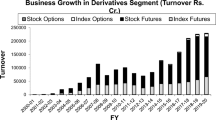Abstract:
We investigate what can be learned from a purely phenomenological study of options prices without modelling assumptions. We fitted neural net (NN) models to LIFFE “ESX” European style FTSE 100 index options using daily data from 1992 to 1997. These non-parametric models reproduce the Black-Scholes (BS) analytic model in terms of fit and performance measures using just the usual five inputs (S, X, t, r, IV). We found that adding transaction costs (bid-ask spread) to these standard five parameters gives a comparable fit and performance. Tests show that the bid-ask spread can be a statistically significant explanatory variable for option prices. The difference in option prices between the models with transaction costs and those without ranges from about -3.0 to +1.5 index points, varying with maturity date. However, the difference depends on the moneyness (S/X), being greatest in-the-money. This suggests that use of a five-factor model can result in a pricing difference of up to £10 to £30 per call option contract compared with modelling under transaction costs. We found that the influence of transaction costs varied between different yearly subsets of the data. Open interest is also a significant explanatory variable, but volume is not.
Similar content being viewed by others
Author information
Authors and Affiliations
Additional information
Received 31 December 2001
Rights and permissions
About this article
Cite this article
Healy, J., Dixon, M., Read, B. et al. A data-centric approach to understanding the pricing of financial options. Eur. Phys. J. B 27, 219–227 (2002). https://doi.org/10.1140/epjb/e20020149
Issue Date:
DOI: https://doi.org/10.1140/epjb/e20020149




